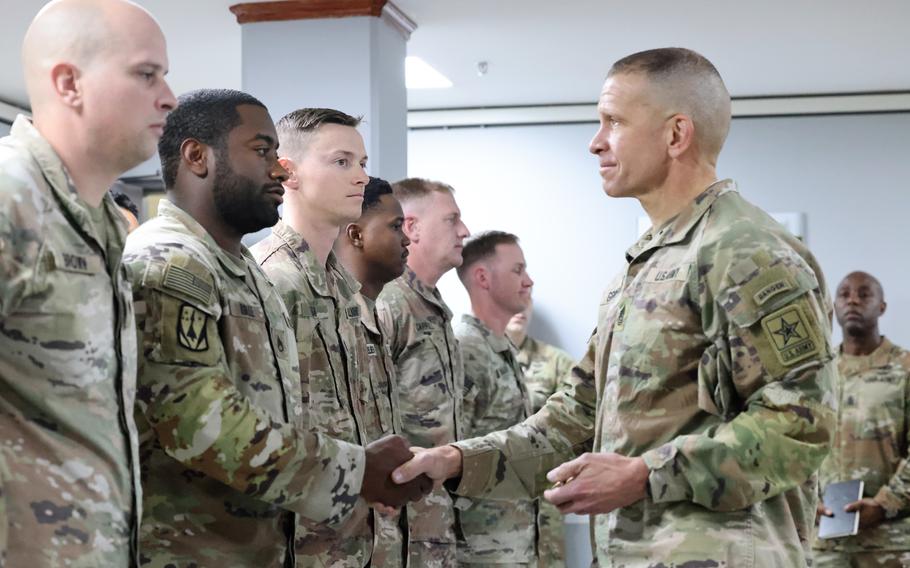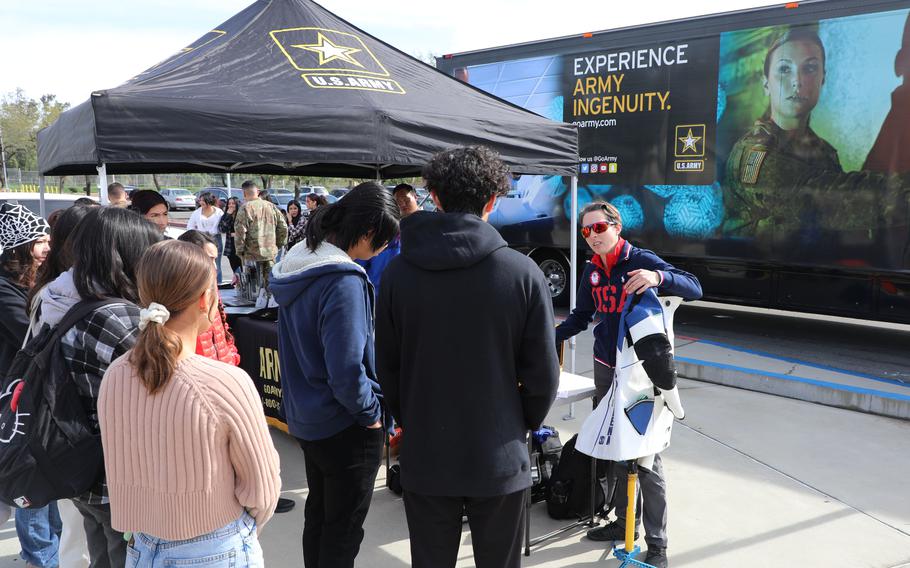
Sgt. Maj. of the Army Michael Grinston awards coins to select exemplary enlisted and noncommissioned soldiers on Dec. 14, 2022, at Camp Arifjan, Kuwait. (Austin May/U.S. Army)
WASHINGTON — The Army hopes some new and revived recruiting incentives will persuade more young Americans to join up this year after a difficult 2022, the service’s top enlisted soldier said Tuesday.
Sgt. Maj. of the Army Michael Grinston warned the service can’t afford to repeat the lackluster performance of last year — when the Army missed its active-duty enlistment goal of 60,000 by 15,000 recruits. For 2023, the goal is to sign 65,000 recruits. More so, the Army missed its end force target for 2022 of 485,000 troops, falling short about 20,000 soldiers.
“We had a tough year last year,” Grinston said during an interview at an Association of the United States Army event. “We cannot do that again. That’s No. 1.”
Each military branch has faced recruiting challenges in the last several years due partly to a diminishing candidate pool. Pentagon data has shown fewer than 25% of all young Americans between the ages of 17 and 24 qualify for military service academically and physically.
Grinston said Tuesday that the Army is engaged in “a ton of efforts” to improve the appeal of life in the service, including a referral program.
“Just announced is the soldier [referral] program, where [if you] recruit one of your buddies … you get promoted,” he said, noting the Army hasn’t used that tactic in a long time. “We just kind of dusted it off.”
The referral program is already active and it works in two different ways. With a referral, soldiers at the E1, E2 or E3 level can get promoted to the next grade or soldiers of any rank can sign up a friend and receive a recruiting ribbon.

Sgt. Sagen Maddalena from the U.S. Army Marksmanship Unit shows her equipment to students from Patriot High School, Jurupa Valley, Calif., on Jan. 11, 2023. The USAMU regularly conducts marksmanship clinics, demonstrations and public appearances for civilians throughout the country. (Kulani Lakanaria/U.S. Army)
Grinston said another effort allows new recruits to choose where they are stationed after they finish basic training. Army officials believe this option should be attractive to families who want a relative to stay closer to home or be assigned to a safe location, he said.
“That is something we haven’t done in a long time,” Grinston said. “We have got a lot of initiatives; we have a whole laundry list.”
Other recruiting efforts include cash bonuses and added resources to help recruiters with quality-of-life issues. For example, Grinston’s office said some recruiters can get additional money for various associated costs such as parking that can vary from city to city.
Army Secretary Christine Wormuth has said she expects the recruiting total will be better in 2023, but it’s too early to tell what the final amount will be. Earlier this week, Maj. Gen. Alex Fink, who leads Army marketing, said the most common obstacles that recruiters see are young people who don’t see the service as relevant to their lives, those who feel joining up would put their lives on hold, and others who see Army life as too dangerous, The Associated Press reported.
One thing several Army leaders have said they won’t do to aid recruiting is lower the eligibility standards.
“We think that quality is more important than quantity,” Gen. James McConville, the Army’s chief of staff, said last month.
Grinston, who has been the sergeant major of the Army since 2019, is set to retire in August and he will be succeeded by Command Sgt. Maj. Michael Weimer, a Green Beret with a long history in special operations. The sergeant major of the Army is the service’s highest-ranked, noncommissioned soldier and acts as an advocate for enlisted members across a range of issues.
Grinston emphasized Tuesday that there’s one avenue that’s key to recruiting — giving young Americans a glimpse of what their lives would look like in the Army. And once they’re in, he said, they’ll want to stay.
“Our retention numbers have stayed steady or higher than they ever have been,” he said. “What that tells us is, we just need to get people into the military, in the Army. Once they get in, they want to stay, they like it.”
The Army has a website — https://www.goarmy.com/refer.html — for information about the referral program and the bonuses that the service is offering, as well as other recruiting-related tools.